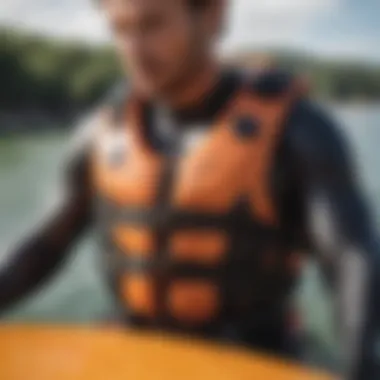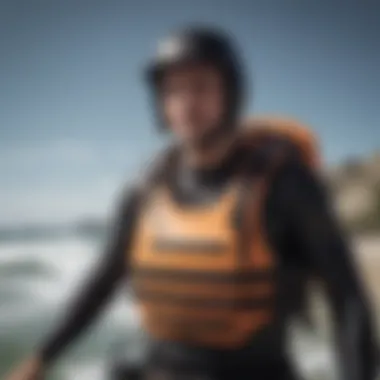The Importance of Buoyancy Vests in Kiteboarding


Intro
Kiteboarding is a breathtaking sport that draws many enthusiasts to the water, but there’s a common thread that often gets overlooked amidst the thrills—the importance of safety gear, particularly buoyancy vests. Beyond just being a piece of attire, buoyancy vests serve as a crucial line of defense against mishaps and accidents that can occur while riding the waves. This article dives into the various dimensions of buoyancy vests, shedding light on their design, functionality, and the tangible safety benefits they offer to users.
Understanding the nuances behind a buoyancy vest is essential for both newcomers and experienced kiteboarders alike. It’s not merely about looking the part; it’s about ensuring that you have the right equipment to enhance your performance and keep you safe. We will explore the different types of buoyancy vests available on the market, discover the materials that optimize comfort and performance, and highlight size considerations that ensure a perfect fit.
Furthermore, as kiteboarding evolves, so does the technology behind buoyancy vests. The article will touch on how industry trends are shaping the designs, functionality, and even aesthetics of these vital safety tools. Maintenance is another key point of discussion, as care practices can significantly affect the longevity and effectiveness of a vest.
All in all, this guide aims to be an indispensable resource for anyone passionate about kiteboarding. Whether you’re a seasoned pro aiming to enhance your gear or a greenhorn stepping onto the water for the first time, understanding buoyancy vests will provide you with the peace of mind needed to truly enjoy the ride.
Gear Insights
When choosing gear for kiteboarding, buoyancy vests should be at the top of your list. They not only provide flotation but also offer added protection against impacts. In this section, we will delve into the latest gear reviews and essential items that beginners should consider.
Latest Gear Reviews
The market is brimming with options, but a few standout buoyancy vests have garnered attention.
- Mystic Marshall Impact Vest: Known for its sleek design and high-quality neoprene, this vest offers impressive buoyancy and comfort, a top choice for many enthusiasts.
- O'Neill Superlite Vest: This is an affordable option that packs a punch without sacrificing quality. It’s lightweight and easy to put on, making it perfect for beginners.
Prelude to Buoyancy Vests in Kiteboarding
When it comes to kiteboarding, safety often takes precedence, and buoyancy vests are a crucial element in ensuring a rider's well-being on the water. The increasing popularity of kiteboarding has highlighted the need for effective safety gear, and buoyancy vests serve as a combination of flotation device and protective clothing. They not only enhance the afloat capacity of riders but also provide additional insulation and some level of impact protection during unpredictable falls.
Understanding how buoyancy vests function can be instrumental, especially for those just dipping their toes into kiteboarding. They are designed to keep the rider's upper body buoyant, ensuring that even if one hits the water unexpectedly, they have a better chance of keeping their head above water, which is essential in various conditions—be it a calm day or during strong gusts of wind.
Moreover, buoyancy vests come in various designs tailored for different levels of expertise and styles of riding. From beginners to advanced kiteboarders, the right vest can dramatically affect comfort and performance. As the saying goes, "a proper fit is a win-win." That’s not just about avoiding awkward flopping around but also about ensuring that the vest works effectively when the need arises.
It’s also worth noting that the material a buoyancy vest is made from can make a world of difference. Lightweight, durable materials are paramount to ensure flexibility while still providing necessary flotation. The benefits of tailored buoyancy vests extend to the style and color as well, with bright options offering additional visibility in the waves.
Additionally, when kiteboarding, one should always be aware of how gear interacts. A buoyancy vest is far more effective when paired with other protective gear, enhancing the overall safety framework.
In the upcoming sections, we will explore not just the importance of buoyancy vests, but also delve into their physics, types, materials, user experiences, and the future innovations that are shaping this essential piece of gear. Let's navigate through the depths of buoyancy vests and emerge with a comprehensive understanding of how they ensure safety and improve kiteboarding experiences.
Understanding the Importance of Buoyancy
In kiteboarding, buoyancy is not just a scientific term; it’s a lifeline. Understanding buoyancy means grasping how objects interact with water, which is pivotal for safety and performance on the water. Kiteboarders must recognize that buoyancy affects their stability, balance, and overall experience while navigating the unpredictable environment of wind and waves.
A buoyancy vest can essentially mean the difference between a blissful ride and a potential hazard. They help maintain a rider’s position on the surface of the water and facilitate quick retrieval after a fall. Also, having that extra support aids in the mental aspect of the sport. Riders are often less anxious, knowing they have a safety layer when venturing into turbulent waters.
The Physics of Buoyancy
Understanding the physics behind buoyancy starts with Archimedes' principle, which states that an object immersed in fluid experiences a buoyant force equal to the weight of the fluid it displaces. This principle applies directly to kiteboarding. When a rider is supported by a buoyancy vest, they displace water, and the vest provides upward force to keep them afloat.
- Weight Distribution: A well-designed vest distributes weight effectively, allowing for better maneuverability.
- Floatation Mechanism: The materials used in these vests—typically foams or other lightweight substances—work together to create a buoyancy effect.
The ability to stay afloat is crucial, especially in rough waters where quick recovery can mean the difference between continued fun and a trip back to shore. A rider with a better understanding of buoyancy can employ techniques to utilize it to their advantage, maintaining their balance even when the wind changes or when they hit choppy waters.
Buoyancy and Safety in Water Sports
Using buoyancy vests enhances safety across the board in water sports.
"Safety should never be an afterthought; it’s the foundation of enjoying any water activity fully."
When kiteboarding, the unpredictable nature of the sea and wind makes it essential to have safety mechanisms in place. Buoyancy vests serve multiple safety roles:
- Enhanced Visibility: Many designs incorporate bright colors or reflective materials, making it easier for other water users to spot you.
- Prevention of Fatigue: The added support can reduce muscle fatigue, enabling longer ride times.
- Quick Recovery: Should a rider fall, buoyancy vests help them return to the surface quickly.
- Confidence Booster: Knowing that there’s a reliable tool providing support allows riders—especially novices—to push themselves beyond their comfort zones without undue stress.
Types of Buoyancy Vests
Understanding the different types of buoyancy vests is crucial for kiteboarders, whether you're just starting out or have years of experience under your belt. Each type carries its own set of characteristics that can influence both safety and performance on the water. When you’re darting across waves or catching air, the right vest can make a world of difference, both in comfort and in keeping you afloat when the unexpected happens.
Inflatable vs. Non-Inflatable Vests
One of the primary distinctions in buoyancy vests lies in whether they are inflatable or non-inflatable. Inflatable vests typically offer higher buoyancy, which can be advantageous in emergency situations. These vests deploy an air bladder upon need, providing an added layer of safety. Kiteboarders may prefer inflatable options during sessions in choppy waters.


In contrast, non-inflatable vests come with built-in foam for buoyancy. They're often seen as more suitable for regular riding since they are generally lighter and more streamlined. Since they do not rely on an air system, there’s no delay in buoyancy—the moment you hit the water, you’re floating. This immediate response can enhance peace of mind, especially for those still honing their skills. However, they may not provide as much lift as inflatable models, which can be a consideration for some riders.
Design Features and Styles
When it comes to design, buoyancy vests exhibit a range of features tailored to enhance the rider’s experience. The variety available caters to different styles and personal preferences, making it essential to explore these options.
Freestyle Vests
Freestyle vests are designed with agility and ease of movement in mind. They often possess minimal bulk while allowing for freedom of motion, crucial for performing tricks and maneuvers. A key characteristic is the slim fit that hugs the body without restricting it, leading to a better feeling on the water.
One unique feature of many freestyle vests is their segmented foam, which lets the vest bend more naturally with the body. This attribute is particularly useful for riders who like to push the limits, as it prevents the vest from interfering with the range of motion. However, they may sacrifice a bit of buoyancy compared to bulkier models, so riders should weigh their style preferences against their safety needs.
Vest Sizes and Adjustability
The size and adjustability of a vest are essential for getting a comfortable fit, directly influencing performance. A well-fitted vest ensures that it doesn’t ride up or shift during rides, which can lead to distraction or even danger, especially in turbulent waters. A standout feature of many modern buoyancy vests is their adjustable straps and customizable fit options, enabling riders to tailor them to their body shape.
Additionally, many vests come in different sizes to accommodate a variety of body types. This wide sizing range allows for an inclusive choice, ensuring everyone can find a vest that suits them. However, larger sizes can sometimes impede mobility, making it vital for riders to try before they buy to strike the right balance between comfort and function.
Color Options and Visibility
Color options might seem like an aesthetic choice, but they play a vital role in safety. Bright colors or designs enhance visibility on the water, which is important not only for fellow riders but also for boaters and other watercraft. Many vests feature fluorescent colors or reflectors that stretch their visibility during lower light conditions.
Investing in a vest with clear visibility features is beneficial, as it can help keep riders safer in crowded areas or tough weather. Luckily, there’s often plenty of variety to satisfy personal style without compromising safety.
The type of buoyancy vest you choose can significantly affect not just your safety but also your overall experience on the water.
In summary, selecting the right buoyancy vest is more than a matter of preference—it's about matching your style, safety needs, and body type. The inflatable versus non-inflatable debate will steer you toward either buoyancy or ease of use, while design details like freestyle fit, adjustability, and color will ensure you are not only safe but also comfortable and visible. In the thrilling world of kiteboarding, equipping yourself with knowledge about the types of buoyancy vests available is the first step toward an enjoyable and secure ride.
Materials Used in Buoyancy Vests
Buoyancy vests are essential for kiteboarding, not just for safety, but also for enhancing the overall experience on the water. The materials utilized in these vests play a significant role in their effectiveness, durability, and comfort. When considering a buoyancy vest, one must evaluate how the specific materials can influence floatation capabilities and rider performance. A well-made vest can mean the difference between a carefree day on the water and a potentially hazardous situation.
Common Materials and Their Properties
Buoyancy vests are usually constructed from a mix of materials, each offering its own benefits. Some of the most commonly used materials include:
- Neoprene: This is a popular choice for its flexibility and insulation properties. Neoprene can conform to the body, providing a snug fit that allows for free movement. It also retains warmth, which is particularly useful in cooler waters, making it a favored option among kiteboarders.
- Foam: Most buoyancy vests incorporate closed-cell foam, which provides buoyancy without adding excessive weight. Foam is also resistant to water absorption, helping to keep the vest lightweight and comfortable throughout use.
- Nylon and Polyester: These fabrics are often used for the outer layer of the vest. They are durable and can withstand the rigors of kiteboarding, including exposure to saltwater and UV rays. Moreover, these materials usually come in various colors, aiding visibility in the water.
Each of these materials contributes to the overall safety and comfort of the vest while catering to the specific needs of different riders.
"Choosing the right materials in your buoyancy vest is like picking the right kite. It can change how you maneuver and feel on the water."
Eco-Friendly Material Choices
In recent years, the shift towards sustainability has led to a growing interest in eco-friendly materials for buoyancy vests. Riders are becoming increasingly concerned with their environmental footprint while enjoying water sports. Here are some material considerations that are making waves:
- Recycled Materials: Some vests now use recycled plastics and foams, minimizing waste and reducing reliance on virgin resources. This practice not only helps the environment but often results in high-quality materials that perform well on the water.
- Biodegradable Options: Various manufacturers are exploring biodegradable materials for their buoyancy vests. These textiles break down more efficiently than conventional plastics, addressing the issues of waste in marine environments.
- Natural Fibers: Though not as common, some companies are working with natural fibers which can be lighter and breathable. These materials help in reducing the overall weight of the vest, enhancing a rider’s comfort and performance.
Using eco-friendly materials not only supports sustainable practices but also reflects a shift in consumer preferences towards products that are less harmful to the planet.
Choosing the Right Buoyancy Vest
Selecting the right buoyancy vest is vital for kiteboarding. The vest not only enhances safety but also significantly influences performance. With a range of designs, materials, and sizes available, kiteboarders must consider several factors to choose a vest that fits well and complements their riding style. When you’re cutting through the waves or gliding above the water, having the right gear can make all the difference.
Sizing Guidelines for Optimal Fit
A well-fitting buoyancy vest is a non-negotiable aspect of kiteboarding. If it’s too loose, you risk the vest riding up during intense maneuvers or getting waterlogged. Conversely, if it’s too tight, it may hamper your movement and restrict breathing. Here’s how to find that sweet spot:
- Measure Yourself: Start by taking accurate measurements of your chest, waist, and hips. Most brands provide sizing charts that can help you match your measurements to the right vest size.
- Try Before You Buy: Whenever possible, try on different vests. Walk around, reach, and simulate kiteboarding movements while wearing it. Make sure it doesn’t pinch or pull in any uncomfortable way.
- Adjustability Features: Look for vests with adjustable straps. This allows for a customized fit that can accommodate changes in clothing or personal comfort over time.
Factors to Consider for Performance
While safety is paramount, performance is also crucial for enhancing your kiteboarding experience. Three key elements stand out in this arena: weight distribution, freedom of movement, and personal comfort.
Weight Distribution
Weight distribution is fundamental in how buoyancy vests function during kiteboarding. A vest that’s designed well will distribute buoyancy evenly across your body. This prevents any awkward shifts in balance while you’re in motion.


- Key Characteristic: An evenly distributed buoyancy ensures stability. For example, vests that utilize integrated foam panels often provide better balance than those with bulkier flotation.
- Benefit and Popularity: Riders deeply appreciate vests that enhance stability without compromising agility. Proper weight distribution allows you to focus on performance rather than being distracted by an unsteady ride.
A unique feature often found in high-quality vests is the use of multi-layer foam, which helps maintain a low profile while maximizing buoyancy. This design allows for a more streamlined profile in the water, giving riders a noticeable advantage.
Freedom of Movement
The ability to move freely while riding is crucial for catching air and landing tricks. If a buoyancy vest restricts your range of motion, you might find it difficult to perform complex maneuvers.
- Key Characteristic: Look for vests designed with flexible materials that allow for maximum movement. Many vests incorporate stretch panels or are contoured to fit the body closely but comfortably.
- Benefit and Popularity: Riders love vests that allow them to twist, jump, and maneuver without feeling constricted. This free movement translates directly to better performance on the water.
A unique aspect of some designs is the mesh side panels found on a number of models. This detail promotes airflow and flexibility, which is essential during hot summer days on the water.
Personal Comfort
Comfort shouldn’t be an afterthought when choosing a buoyancy vest. It involves fit, material choice, and temperature regulation, all of which contribute to an enjoyable riding experience.
- Key Characteristic: Look for vests with soft linings and appropriate padding. Neoprene, for instance, is a popular choice because it provides warmth and comfort.
- Benefit and Popularity: Comfortable vests allow riders to stay out on the water longer, focusing on enjoyment rather than discomfort. Moreover, vests that fit well can help beat the chill on cooler days, ensuring a pleasant experience overall.
One unique feature to consider is vests with additional insulation or ventilation options. For instance, some vests come with removable insulation layers that can be adjusted based on the weather conditions.
"Choosing a buoyancy vest is not merely about safety; it's about finding the right balance between protection, comfort, and performance on the water."
By keeping these sizing guidelines and performance factors in mind, kiteboarders can make informed decisions when selecting their buoyancy vests, ensuring not only safety but an enhanced experience when riding the waves.
Safe Practices When Using Buoyancy Vests
When it comes to kiteboarding, ensuring that one practices safety isn’t just an afterthought—it's a necessity. Buoyancy vests significantly contribute to rider safety, but even the best equipment has limits. This section shines a light on paramount safe practices to adopt while using buoyancy vests. It’s all about being smart and taking those extra steps to protect oneself on the water, preventing accidents before they even arise.
Pre-ride Safety Checks
Before setting sail, carrying out pre-ride safety checks is crucial. Imagine you’re about to embark on an exciting kiteboarding session, and everything appears in order. Yet, can you say that with certainty? Here’s a handy checklist to ensure your buoyancy vest and gear are good to go:
- Inspect the Vest: Check for any visible signs of wear and tear, like frayed straps or punctured inflatable bladders. A small hole can lead to serious trouble once you hit the water.
- Check Fastenings: Make sure buckles and zippers work properly. A vest that comes loose mid-ride could be a recipe for disaster.
- Proper Sizing: Confirm the vest fits snugly, without being too tight. An ill-fitting vest can hinder movement or, worse, compromise safety.
- Helmets and Kite: Ensure that your helmet is securely fastened and that your kite, lines, and bar are in good working condition. Check the condition of lines for fraying or kinks. A small issue there could lead to a larger catastrophe while kiteboarding.
Taking the time to go through this checklist not only enhances safety but also builds confidence for your ride.
Integration with Other Safety Gear
While buoyancy vests are a standout feature in kiteboarding safety, they’re just one piece of a larger puzzle. Integrating your vest with other safety equipment can amplify your preparedness for unforeseen circumstances. Here’s how:
- Helmet: Always wear a certified helmet. It’s a no-brainer. A helmet not only protects your head in case of a fall, but it can also safeguard against unexpected impacts from your own gear.
- Impact Vest: Some kiteboarders opt to wear an impact vest under their buoyancy vest for extra cushioning against hard falls. That added layer can make all the difference during higher-impact maneuvers.
- Cutting Tools: Keep a safety knife readily accessible. In case you get tangled in lines, a quick slice can save the day. It’s a simple precaution that can prevent getting stuck or, even worse, drowning if you’re caught in tricky currents.
- Communication Devices: If you’re heading out into remote water, consider carrying a whistle or a waterproof communication device. This can be a lifesaver in emergencies, allowing you to alert others if you find yourself in a tight spot.
Remember, it pays to be prepared. Integrating various safety items can mean the difference between a fun day on the water and a potentially dangerous situation. By ensuring that your buoyancy vest works hand in hand with your overall safety plan, you set the stage for a memorable kiteboarding adventure—focused on excitement and exploration, rather than anxiety over safety concerns.
Maintenance and Care of Buoyancy Vests
Taking care of buoyancy vests is essential for several reasons, most notably for the continued safety and performance they provide. Just like any piece of gear used in water sports, where conditions can be harsh, a buoyancy vest deserves regular attention. The wear and tear that comes from sun exposure, saltwater, and sand can slowly degrade the materials, leading to decreased functionality over time. Adopting a well-thought-out maintenance routine not only prolongs the lifespan of the vest but also ensures that it functions effectively every time you hit the water.
Cleaning and Storage Tips
Keeping your buoyancy vest clean is crucial. A gunked-up vest is not just an eyesore; it can also become less buoyant due to dirt and salt buildup. Here are some effective cleaning practices:
- Rinse After Use: After each kiteboarding session, give your vest a good rinse in fresh water. This washes off salt, sand, and pollutants that can degrade the materials.
- Mild Soap Usage: If you find significant dirt stains, a bit of mild soap can work wonders. Just make sure to rinse thoroughly, as soap residue can irritate the skin.
- Air Dry: Never toss your vest in the dryer. Instead, hang it to dry in a shaded area. Direct sunlight can fade colors and weaken the fabric over time.
Storage is another element where attention pays off. Instead of crumpling it up or tossing it into a bag, follow these guidelines:
- Roll, Don’t Fold: Rolling the vest helps maintain its shape. If it's folded, creases can become permanent, affecting the vest's buoyancy.
- Avoid Damp Environments: When storing, keep it in a dry place. Damp or humid conditions can invite mold and mildew, which tarnish the vest's usability.
Repair Techniques for Damage
Despite your best efforts, damage can still occur, whether it's from an unexpected wipeout or snagging on an object. Learning how to effectively repair a buoyancy vest can save you time and money while ensuring you’re always ready to ride.
- Patch Small Tears: For tiny rips, consider using a fabric adhesive patch. These are available in many sporting goods stores, and application is straightforward: clean the area, apply the patch, and let it set.
- Sewing Larger Damages: If your vest sustains a larger tear, a sewing kit can work wonders. Use a strong thread and a needle designed for heavy fabrics. Make sure your stitches are tight and close together to prevent further tearing.
- Replace Floatation Inserts: If the vest’s inner floatation foam becomes damaged or squished, you might be able to replace it. Some manufacturers provide this service or sell compatible inserts, which can restore your vest’s buoyancy without needing a complete replacement.
In essence, the maintenance and care of buoyancy vests is not just a choice but a necessity for anyone serious about kiteboarding. Proper cleaning and timely repairs can keep your buoyancy vest in top-notch shape, ensuring it provides the support and safety it is designed for, session after session.


"Caring for your gear is part of the joy of the sport greatly used and appreciated by kiteboarders worldwide."
By focusing on the longevity and reliability of your buoyancy vest, you create a safer and more enjoyable experience on the water.
User Experiences and Testimonials
Understanding the real-life experiences of users can significantly enhance the value of this article. When kiteboarders share their stories, it adds a rich layer of practical knowledge to the theoretical aspects discussed earlier. Personal testimonies often provide insights that statistics and product descriptions may overlook, thus allowing both beginners and experienced riders to assess the role of buoyancy vests in real-world scenarios.
In the world of kiteboarding, safety is paramount, and buoyancy vests play a critical role in ensuring that. Users often highlight how these vests not only provide security while maneuvering through choppy waters but also enhance their confidence. Such testimonials are vital in revealing how a piece of gear can impact not just physical safety but also mental assurance when tackling the ocean’s waves.
Insights from Beginners
Beginners venturing into kiteboarding often express a mix of excitement and anxiety about their new hobby. Many report that wearing a buoyancy vest alleviates their fears. One common sentiment among novice riders is the reassurance derived from the vest’s buoyancy during mishaps, particularly during their early attempts at take-offs and landings.
Many novices have shared that the first time they fell into the water, the vest seemed to lift them right back up, almost like a guardian angel of sorts. Some have pointed out the buoyancy vest's role in keeping them afloat while they grapple with the kite—helping them focus on learning rather than panicking.
For instance, a beginner from Florida detailed their struggle on a windy day, mentioning how their vest kept them calm after an unexpected wipeout. They remarked, "If it hadn't been for that vest, I probably would've spent more time worrying than learning the rope."
Their experiences underline a crucial benefit: beginners, in particular, gain a sense of freedom to explore new techniques, knowing that the vest adds a layer of protection against the unyielding sea.
Advanced Riders' Perspectives
On the flip side, advanced riders tend to have a different approach. For them, buoyancy vests are an essential component of their equipment arsenal. Many seasoned kiteboarders emphasize the importance of choosing a vest that aligns with their performance needs. They value aspects such as streamlined design, weight distribution, and minimal bulk of the vest, which can affect their agility and control while riding.
One advanced rider—a kiteboarding instructor—shared their preference for a lightweight vest that doesn't hinder movement, saying, "I want to feel like I'm one with the board, not weighed down by safety gear." Their experience reflects a common sentiment among this group, prioritizing the balance between safety and performance.
Moreover, seasoned kiteboarders often wear buoyancy vests not just for safety but also as a strategic choice. They sometimes integrate innovative features, such as pockets for accessories or even hydration packs, tailored to enhance their experience on the water. The emphasis on practicality and design is often echoed in their feedback, making it clear that while safety remains a priority, performance and convenience must not be sacrificed.
To summarize, the narratives shared by both beginners and advanced riders shine a light on how perceptions of buoyancy vests evolve with experience. Whether finding solace in safety or pushing the limits of performance, user experiences underscore the adaptable role of buoyancy vests, ultimately enriching the kiteboarding journey for riders at all levels.
Future Trends in Buoyancy Vest Technology
The realm of kiteboarding is no longer just about wind and water; it's about technology and innovation as well. Future trends in buoyancy vest technology are shaping how both safety and performance are perceived in the kiteboarding community. The growing emphasis on safety features, alongside advancements in materials and electronic enhancements, highlight a compelling evolution in the design and functionality of buoyancy vests.
Innovations in buoyancy vest technology are crucial for various reasons. For one, as more adventurous people take to the water, the necessity for gear that can adjust and adapt to varied circumstances is paramount. Moreover, improved materials not only enhance comfort but also offer more effective safety measures. The convergence of safety and technology spells a bright future for kiteboarding participants, giving them peace of mind while they ride the waves.
Innovations in Material Science
Material science is doing wonders, especially in the kiteboarding sector. Recent advancements have led to buoyancy vests made from lighter, more durable, and flexible materials. These innovations make vests not only easier to wear but more efficient in water. For instance, vests utilizing closed-cell foam have become a popular choice. This foam provides excellent buoyancy while also being resistant to water absorption.
In addition, some manufacturers are even exploring the use of biodegradable materials. This shift reflects a wider trend toward sustainability and environmental responsibility, which is increasingly important to today’s consumers. By opting for eco-friendly options, kiteboarders are aligning their passion with a commitment to protecting the natural spaces they enjoy.
Advantages of New Material Science Innovations include:
- Lighter Weight: Easier to maneuver during intense kiteboarding.
- Durability: These materials withstand harsh outdoor conditions longer than traditional options.
- Breathability: Improved ventilation means better comfort during lengthy sessions on the water.
Smart Vests and Wearable Tech
Kiteboarders today are becoming more tech-savvy, leading to a rising interest in smart vests and wearable technology. These vests go beyond simple buoyancy; they are equipped with sensors that monitor a rider’s movements, heart rate, and even environmental conditions. This data can be pivotal for assessing performance and safety.
Imagine riding and having real-time feedback on how your body is responding to the elements! Some designs are even integrating GPS technology to track routes and provide geographical information, an exciting prospect for those who love to explore new waters.
"Innovative vests can help riders keep track of their performance metrics, offering a blend of safety and enhancement for kiteboarding experience."
Additionally, connectivity features allow users to connect via apps, sharing data with coaches or friends, thus enhancing the social aspect of the sport. This blend of functionality leads not only to improved safety but also facilitates a more engaging and informed riding experience.
Key Benefits of Smart Vests:
- Performance Tracking: Keeps track of your ride metrics.
- Safety Alerts: Notifications for irregular heart rates or prolonged inactivity.
- Environmental Awareness: Real-time data on wind conditions can improve decision-making while riding.
In summary, as kiteboarding evolves, so too does the equipment that enhances the experience and safety of its participants. The future looks promising, and as buoyancy vest technology continues to advance, kiteboarders can expect smarter, lighter, and more durable options on the market.
Culmination
Buoyancy vests are an essential part of kiteboarding, marrying safety with functionality. Their significance stretches beyond mere floating assistance; they boost confidence and encourage participation in the sport by reducing fears associated with water activities. Riders equipped with proper buoyancy vests are not just safer; they're more likely to push their limits, enhancing their overall experience.
Reassessing the Value of Buoyancy Vests in Kiteboarding
When we think about kiteboarding, often the first thoughts go to skills and gear like the board or kite itself. Yet, the importance of buoyancy vests shouldn't be swept under the rug. They offer numerous features that align perfectly with the needs of both novice and expert riders.
- Safety Features: Just like a well-fitted seatbelt, a buoyancy vest plays a critical role in safeguarding the rider, particularly in rough waters or high winds. Many vests come with additional safety features, such as reflective strips, to ensure visibility, especially during low-light conditions.
- Comfort and Mobility: These vests provide essential floatation without drastically sacrificing range of motion. Riding with a vest that fits well makes one feel almost like it's a second skin. A snug yet flexible vest allows for more dynamic maneuvers.
- Confidence Boost: For those still getting their feet wet—literally—a buoyancy vest can be a game-changer. It allows new riders to focus less on fear and more on learning the ropes.
- Community Standards: As the kiteboarding community has evolved, the expectation for wearing buoyancy vests has only increased. Not wearing one might draw raised eyebrows, especially among seasoned professionals.
In summary, the value of buoyancy vests is multifaceted. They not only contribute to individual safety but also enhance the overall kiteboarding experience. With innovations on the horizon and the community's acknowledgment of their importance, buoyancy vests will likely continue to evolve, ensuring both sport safety and rider enjoyment for years to come.















